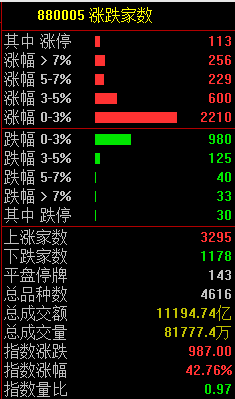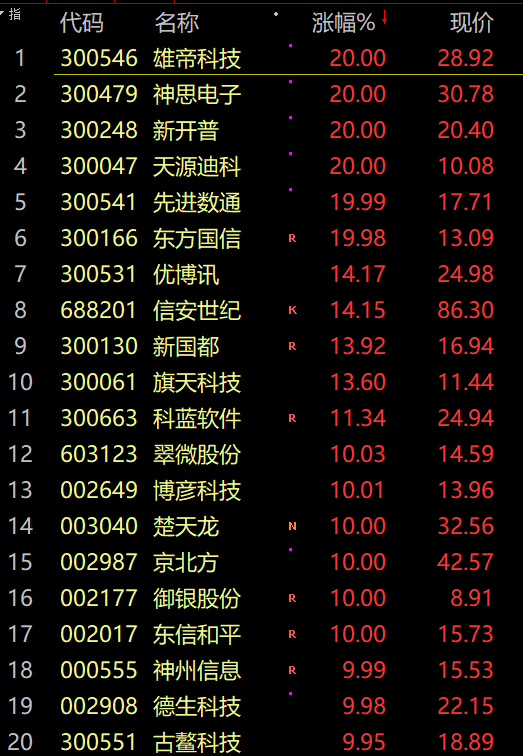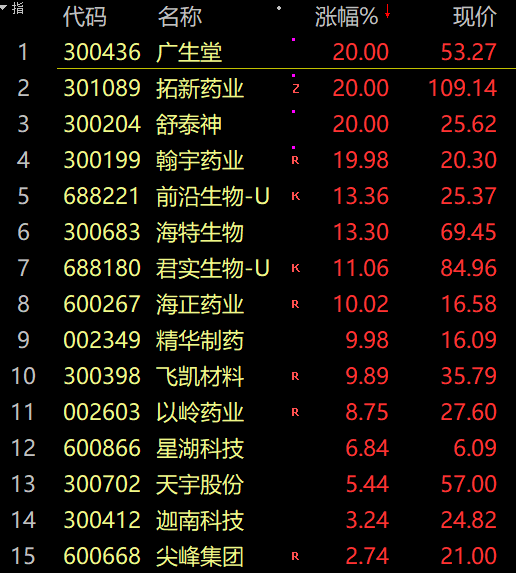In today’s stock market, A shares have risen due to a cloud-piercing arrow of the central bank’s “interest rate cut”. I wonder if everyone has eaten meat?
A shares soared after the central bank released favorable
More than 100 shares in the two cities rose by the daily limit
January 17,Shanghai IndexIntraday maintained a strong upward trend, the Shenzhen Component Index,GEM refers toBoth rose sharply, with an increase of more than 1.5%; the full-day turnover of the two cities exceeded 1.1 trillion, and the northbound funds were once intraday.net inflowOver 3 billion yuan, and there was a return in late trading.
As of the close, the Shanghai Composite Index rose 0.58% to 3,541.67 points, the Shenzhen Component Index rose 1.51% to 14,363.57 points, and the ChiNext Index rose 1.63% to 3,170.41 points; the two cities had a total turnover of 1,119.7 billion yuan, and northbound funds bought a net 1.707 billion yuan.

In general, stocks rose more and fell less today, with more than 3,200 stocks rising. The turnover of the Shanghai and Shenzhen stock exchanges was 1,119.7 billion today, which was 12.7 billion higher than the previous trading day.

on the board, numberscurrencyThe plate oscillated stronger in the afternoon,Xiongdi Technology、Shensi Electronics、new cape、Tianyuan Diko、Advanced digital communication20CM daily limit,Oriental Guoxin、Youboxun、Principal Century、Qitian Technology、New country capitalrose more than 10%.

The concept of new crown medicine broke out again,Tuoxin Pharmaceutical、Guangshengtang、Hanyu Pharmaceutical、Shutai GodWait for the “20cm” daily limit.

Ningde eraIt once rose more than 5% to support the ChiNext Index.
Is there necessarily a bull market after a rate cut? Dongxing strategy analysis said that there is a short-term boost, and the long-term impact is not obvious. After the rate cut, the index rose significantly on the day. Since 2010, the Shanghai Composite has risen eight times and fell three times within a day after the rate cut. However, after 1 week and 1 month, the number of rises and falls was basically the same, and there was no obvious pattern. A rate cut does not guarantee a trend rebound, but there is a structural opportunity. At present, we are in a period of downward fundamentals and loose policy protection and hedging. There are still ups and downs in the short term, and long-term easing is gaining momentum, and the overall warming may be after the Spring Festival.
CITIC Construction InvestmentThe analysis said that in terms of subsequent interest rate cuts, we must continue to observe, but the interest rate cut window has not been closed, and there is still a possibility of interest rate cuts in the first quarter. This time, MLF and OMO lowered 10BP, slightly exceeding the market expectation of 5BP, and the expectation of subsequent interest rate cuts may be reduced. However, at present, the pressure to stabilize growth, reduce costs, prevent risks, and support the real economy is still great, and the situation of weakening supply and demand and expectations has not changed significantly, so there is still a possibility of interest rate cuts in the first quarter.
The number of births has dropped again
According to the National Bureau of Statistics, by the end of 2021, the national population (including the population of 31 provinces, autonomous regions, municipalities and active military personnel, excluding Hong Kong, Macao and Taiwan residents and foreigners living in 31 provinces, autonomous regions and municipalities directly under the Central Government) was 1,412.6 million.An increase of 480,000 people over the end of the previous year.
The annual birth population was 10.62 million, with a birth rate of 7.52‰; the death population was 10.14 million, with a population death rate of 7.18‰; the natural population growth rate was 0.34‰.
In terms of gender composition, the male population is 723.11 million and the female population is 689.49 million, with a sex ratio of 104.88 (with females being 100).
In terms of age composition, the working-age population aged 16-59 is 882.22 million, accounting for 62.5% of the national population; the population aged 60 and above is 267.36 million, accounting for 18.9% of the national population, of which 200.56 million are aged 65 and above people, accounting for 14.2% of the national population.
From the perspective of urban and rural composition, the urban resident population was 914.25 million, an increase of 12.05 million over the end of the previous year; the rural resident population was 498.35 million, a decrease of 11.57 million; the urban population accounted for 64.72% of the national population (urbanization rate), an increase of 64.72% over the end of the previous year. An increase of 0.83 percentage points.
The national population separated from households (that is, the population whose place of residence and household registration are not in the same township and street and who have left the household registration place for more than half a year) was 504.29 million, an increase of 11.53 million over the previous year; among them, the floating population was 384.67 million, an increase of 384.67 million over the previous year. An increase of 8.85 million.
According to data released by the National Bureau of Statistics, from 2011 to 2015, China’s annual birth population was above 16 million. In 2016, the comprehensive two-child policy was implemented, and the number of births that year reached 17.86 million. The birth population in 2017 reached 17.23 million. After 2018, with the basic release of fertility potential after the implementation of the universal two-child policy, the number of births showed a downward trend. The number of births fell to 15.23 million in 2018. In 2019, China’s birth population fell to 14.65 million. In 2020, there will be a relatively sharp decline, with 12 million births that year. The number of births in 2021 will drop by another 1.38 million compared to 2020.
From the point of view of the natural population growth rate, my country has approached the population “zero growth”. In 2021, the number of births in my country will be 10.62 million, with a birth rate of 7.52‰; the death population will be 10.14 million, with a mortality rate of 7.18‰; the natural population growth rate will be 0.34‰.
According to the data of the National Bureau of Statistics, the net population increase over the years since 1949 was sorted out and found that the net population increase in 2021 has hit a new low in the past 60 years (since 1962).

my country’s total population will remain above 1.4 billion for a period of time
“Depopulation is the result of a combination of factors”
In 2021, the number of births in my country will decrease compared with the previous year, and the birth rate will drop. Ning Jizhe said that the population decline is the result of the combined influence of many factors. “The slowdown in population growth is an objective result of my country’s economic development, especially industrialization and urbanization to a certain stage. Aging and low birthrate are also common problems faced by developed countries and even some emerging economies.” Ning Jizhe pointed out that the main reasons are There are three aspects:
First, the number of women of childbearing age continued to decrease. In 2021, the number of women of childbearing age aged 15-49 will decrease by about 5 million compared with the previous year, of which the number of women of childbearing age between the ages of 21 and 35 will decrease by about 3 million.
Second, fertility levels continue to decline. In recent years, the concept of fertility has changed, and the age of marriage and childbearing is also being postponed. Coupled with other factors that increase the cost of childbirth, the willingness of young people to bear children has decreased.
Third, the new crown pneumonia epidemic has also delayed the marriage and childbearing arrangements of young people to a certain extent. A number of international investigations and studies have found that since the outbreak of the epidemic, fertility levels in many countries and regions have declined. In 2020, the number of births in Japan will decrease from the previous year, and the number of births in South Korea will also decrease from the previous year.
Ning Jizhe pointed out that for a period of time in the future, my country’s total population will remain above 1.4 billion. It is mainly reflected in the following three aspects:
First, there are more women of childbearing age. my country has a large population base. At present, there are still more than 300 million women of childbearing age. The number of births of more than 10 million people can be maintained every year, and the total population will maintain a certain level of growth.
Second, the effect of the “three-child” policy will gradually emerge. In the past ten years, fertility policies such as “separate two-child” and “universal two-child” have achieved positive results, and the number of births has increased. According to the data of the seventh national census, the population of children aged 0-14 increased by more than 30 million compared with 2010, and the proportion increased by 1.35 percentage points. It is mainly because the two “two-child” birth policies have promoted the increase in the fertility rate. Among the births, the proportion of “second children” will increase from about 30% in 2013 to about 43% in 2021. In May 2021, the Political Bureau of the Central Committee proposed to further optimize the fertility policy, implement the policy that a couple can have three children and supporting measures.
Third, the life expectancy of the population continues to increase. my country’s medical and health conditions have been greatly improved, people’s living standards have been continuously improved, life expectancy has been continuously extended, and the number of deaths has always been less than the number of births, which helps the total population to maintain a growth trend. Some delayed births will continue to be released for a period of time in the future, and these factors will play a positive role in keeping the total population basically stable.
(Article source: Chinafundnewspaper)
.
